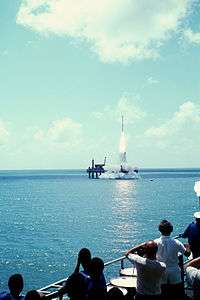San Marco programme
The San Marco programme was an Italian satellite launch programme conducted between the early 1960s and the late 1980s. The project resulted in the launch of the first Italian-built satellite, San Marco 1, on December 15, 1964.[1] With this launch Italy became the third country in the world to operate its own satellite, after the Soviet Union and the United States.[2][3][4] San Marco was a collaboration between the Italian Space Research Commission (CRS) (a branch of the National Research Council), led by Luigi Broglio and Edoardo Amaldi, and NASA. In total 5 satellites were launched during the programme, all using American Scout rockets. The first flew from Wallops Flight Facility with the rest conducted from the San Marco Equatorial Range. The last satellite, San Marco-D/L, launched on March 25, 1988.

History

Luigi Broglio, who had gained aeronautical experience during World War II, became a major in the Aeronautica Militare Italiana (AMI) in 1950. In 1956 he was assigned leadership of the force's Ammunition Research Unit, responsible for the military's rocket programme, by General Secretary of Aeronautics Mario Pezzi. The unit ran the Salto di Quirra rocket test range on Sardinia and Broglio would have his first experience of working with American rocketeers when the AMI was involved in weather experiments using Nike-Cajun rockets to release sodium clouds for study.[5]
While Soviet and American teams had been working on plans for orbiting research satellites for a number of years, the launch on 4 October 1957 of the world's first artificial satellite, Sputnik 1, began the Space Race in earnest and America soon launched its own Explorer 1 system in response. After Sputnik there was a desire from other countries to enter this new field of research and technological capability.[6][7]
In February 1961 Broglio introduced the idea to Prime Minister Amintore Fanfani that Italy should pursue a satellite research programme of its own, launched from its own facility. Although conceived as a national programme, sourcing of foreign launchers was accepted to accomplish the goal.[7] In that same year, at a meeting of the Committee on Space Research (COSPAR) in Florence, Broglio had discussions with some NASA officials present and proposed the idea of the US supplying launchers and training Italian ground crews to fire them for this effort.[5]
The San Marco programme was approved by the Italian government in October 1961 with a formal Memorandum of Understanding between the CRS (represented by Broglio) and NASA (represented by Hugh Dryden) being signed on May 31, 1962.[6][8] The plan was for the US to provide the Scout rockets and train the Italian ground crew while Italy would develop the satellites and provide the launch pad. The Italian oil company Eni provided the San Marco platform, a mobile Jackup barge that could be towed to an equatorial location, which when combined with an easterly firing provides the most energetically favourable launch.[9] Test flights using Shotput rockets as well as the first San Marco satellite would be launched from the America's Wallops Flight Facility as training for the Italian ground crew in preparation for future launches.
While all launches were successful, Italy would go on to primarily pursue cooperation through European Launcher Development Organisation and the European Space Research Organisation and ultimately their successor the European Space Agency.
Missions
| Launch Date | Vehicle | Payload | NSSDC ID | Comments |
|---|---|---|---|---|
| 15-12-1964 | Scout-X4 | San Marco 1 | 1964-084A | |
| 26-04-1967 | Scout B | San Marco 2 | 1967-038A | |
| 24-04-1971 | Scout B | San Marco 3 | 1971-036A | |
| 18-02-1974 | Scout D-1 | San Marco 4 | 1974-009A | |
| 01-07-1983 | Scout G-1 | San Marco D/M | SANM-DM | Cancelled |
| 25-03-1988 | Scout G-1 | San Marco D/L | 1988-026A |
See also
- Luigi Broglio
- Wallops Flight Facility
- Scout
- Broglio Space Centre – modern name of the San Marco Equatorial Range
References
- Harvey, Brian (2003). Europe's space programme: to Ariane and beyond. Springer-Praxis books in astronomy and space sciences. pp. 110–118. ISBN 1-85233-722-2.
- http://crpsm.psm.uniroma1.it/
- NASA Space Science Data Coordinated Archive
- "The Impact of the Alouette". www.ieee.ca. Retrieved 2020-02-19.
- "The Dreamers – Luigi Broglio" (in Italian). Italian National Institute for Astrophysics – Astronomical Observatory of Bologna. Retrieved 2010-08-25.
- Michelangelo De Maria; Lucia Orlando; Filippo Pigliacelli. "Italy in Space 1946–1988" (PDF). European Space Agency. pp. 5, 13–14. Retrieved 2010-08-24.
- "Chapter 18 – Cooperation With Western Countries". NASA History Office. Archived from the original on 2007-08-23. Retrieved 2010-08-24.
- "No.6663 United States of America and Italy" (PDF). The United Nations. Retrieved 2010-08-27.
- "II. SATELLITES". NASA History Office. Archived from the original on 2004-11-04. Retrieved 2010-08-24.